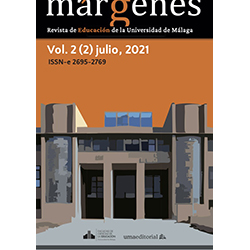History of living library in a rural school. An ethnographic account
DOI:
https://doi.org/10.24310/mgnmar.v2i2.12807Keywords:
multigrade group, school library, reading students, Community participation, ethnographyAbstract
This article has the purpose of providing knowledge about the social construction of school libraries in rural contexts, their pedagogical uses and their training potential. An experience is documented that intertwines the curriculum, the educational community, signified in the diversity of a multigrado group and its family and social environment. It is an ethnographic account of the educational possibilities of a library in a rural Mexican school, where boys and girls of different ages coexist and share stories that the teacher reads aloud, with the desire to spread a taste for reading and writing I their children’s minds and hearts. Despite deficiencies and dropouts, the school manages to have a rich heritage that students classify, care for and use for their own benefit. They become guardians of the books and teachings behind their pages. The library constitutes a cultural space that creates possibilities for exchange and openness to world for students and their families. And it certainly offers wings for those who undertake the journey of literary pleasure. The story is based on ethnographic research on the diversity of pedagogical resources that circulate in multigrado schools located in rural territories.
Downloads
Metrics
Publication Facts
Reviewer profiles N/A
Author statements
Indexed in
-
—
- Academic society
- N/A
- Publisher
- Universidad de Málaga
References
Bonilla, O., Goldin, D., Salaberria, R. (2014). (Coords). Bibliotecas y escuelas. Retos y posibilidades en la sociedad del conocimiento. Editorial Océano.
Cano, A. e Ibarra, E. (Coords.) (2018). Vulnerabilidad, innovación y prácticas docentes en escuelas multigrado. RIER-UPES- Editora Nómada.
Castán, G. (2014). “La biblioteca escolar y la igualación de oportunidades”. En Bonilla, O., Goldin, D., Salaberria, R. (Coords). Bibliotecas y escuelas. Retos y posibilidades en la sociedad del conocimiento (1- 42). Editorial Océano.
Eisner, E. (1998). El ojo ilustrado. Indagación cualitativa y mejora de la práctica educativa. Paidós educador.
Galván, L. y Espinosa, L (2017). Diversidad y prioridades educativas en escuelas multigrado. Estudio de caso en México. Sinéctica. Recuperado de https://sinectica.iteso.mx/index.php/SINECTICA/article/ view/715
Galván L., Solares D. y Espinosa L. (2018). “Recursos pedagógicos para la enseñanza: una noción desde el aula multigrado”. En A. Cano y E. Ibarra (Coords.) Vulnerabilidad, innovación y prácticas docentes en escuelas multigrado (61-86). RIER-UPES-Editora Nómada.
Geertz, C. (2005). La interpretación de las culturas. Gedisa.
Hammersley, M. y Atkinson, P. (1994). Etnografía. Métodos de investigación. Paidós.
Kalman, J. (2004). Saber lo que es la letra. Una experiencia de lectura con mujeres en Mixquic. Biblioteca para la Actualización del Maestro. UNESCO/Siglo XXI Editores/SEP.
Lerner, D. (2001). Leer y escribir en la escuela. Biblioteca para la Actualización del Maestro. Secretaría de Educación Pública/Fondo de Cultura Económica.
Pitzorno, B. (2008). Escúchame el corazón. Sabina Editorial.
Robledo, B. (2014). “Una cartografía inconclusa: la realidad de las bibliotecas escolares en nuestros países”. En O. Bonilla, D. Goldin, y R. Salaberria (Coords). Bibliotecas y escuelas. Retos y posibilidades en la sociedad del conocimiento (1-22). Editorial Océano.
Rockwell, E. (2009). La experiencia etnográfica. Historia y cultura en los procesos educativos. Paidós. Secretaría de Educación Pública. (2011). Plan de estudios 2011. Educación Básica. SEP.
Downloads
Published
How to Cite
Issue
Section
License
The editorial team of Márgenes supports an open Access policy of scientific knowledge. apostamos claramente por una política de acceso abierto del conocimiento científico (see Berlin Declaration).
Authors with work published in this journal accept the following conditions:
- This journal provides immediate free access to its content under the principle of making research freely available to the public. All contents published in Márgenes are subject to the Creative Commons Reconocimiento-SinObraDerivada 4.0 Internacional
It is the responsibility of the authors to obtain the necessary permissions of the images that are subject to copyright.
Authors whose contributions are accepted for publication in this journal will retain the non-exclusive right to use their contributions for academic, research and educational purposes, including self-archiving or deposit in open-access repositories of any kind.
The electronic edition of this magazine is edited by the Editorial of the University of Malaga (UmaEditorial), being necessary to cite the origin in any partial or total reproduction.
- Authors can enter into other additional independent contractual agreements for the non-exclusive distribution of the version of the article published in this journal (e.g. including it in an institutional repository or publishing it in a book) on the condition that they clearly indicate that the work was originally published in this journal.
- Authors are allowed and recommended to publish their work on the Internet (for example on institutional and personal websites), before and after the publication, as this could lead to constructive exchanges and a more extensive and quick circulation of published works (see The Effect of Open Access).















